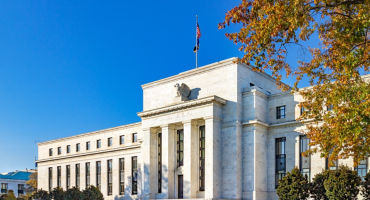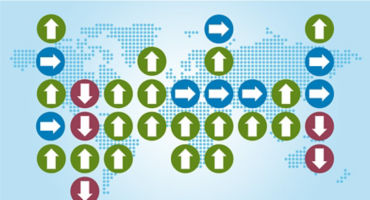- Fixed Income Portfolio Manager
Skip to main content
- Funds
- Insights
- Capabilities
- About Us
- My Account
The views expressed are those of the author at the time of writing. Other teams may hold different views and make different investment decisions. The value of your investment may become worth more or less than at the time of original investment. While any third-party data used is considered reliable, its accuracy is not guaranteed. For professional, institutional, or accredited investors only.
This is an excerpt from our 2023 Investment Outlook, in which specialists from across our investment platform share insights on the economic and market forces that we expect to influence portfolios in the year to come. This is a chapter in the Bond Market Outlook section.
Like many global fixed income sectors, the high-yield bond market has struggled mightily year to date. For example, the ICE BofA Global High Yield Constrained Index had returned a dismal -16.03% as of September 30, 2022. With any luck, 2023 will be a better year, but high-yield investors may want to exercise a measure of patience and be prepared to capitalize on market dislocations when they arise.
Fortunately, I expect there to be no shortage of opportunities for investors to take advantage of high-yield market dislocations in 2023, particularly amid some of the macro risks I am watching — notably, tighter global monetary policies and debt sustainability concerns in Europe as borrowing costs rise. Broadly speaking, I believe a close-to-neutral risk posture may make sense in the coming months, but while maintaining sufficient liquidity to deploy capital at potentially more attractive high-yield valuations.
There has been some easing of supply-chain bottlenecks and energy prices in recent months. However, global monetary policies likely will remain restrictive, in aggregate, in an effort to weaken consumer demand and thereby bring down persistently high inflation. Thus, I am closely monitoring the risk of a policy mistake by one or more central banks, as they attempt to toe the line between keeping inflation in check and not tanking their economies. In Europe, any adverse impacts on growth from European Central Bank (ECB) rate hikes should be partially offset by expansionary fiscal policies.
While I expect the macroeconomic backdrop to deteriorate further, I do not anticipate a deep global recession or a full-scale credit default cycle. Rising input costs contribute to weaker corporate fundamentals, but they also lower the cost of debt in real terms over time. Unhedged floating-interest expenses may become a concern for lower-quality companies with large floating-rate liabilities in their capital structures. The new-issue market is reopening for issuers that are willing to pay higher borrowing costs, but given the relative lack of refinancing needs, few have chosen to take advantage so far.
Following the recent high-yield market sell-off, I believe today’s lower dollar price and higher-rate setting may present attractive entry points for longer-term investors. That being said, patience may well be a virtue when it comes to increasing one’s high-yield risk exposure. Tail risks are rising in an environment of evaporating market liquidity, and I suspect that some of the economic and market excesses created by a prolonged period of low rates will become sources of volatility as they are being unwound.
As of this writing, one of the best risk/reward trade-offs I observe in the global high-yield opportunity set is in the lower part of the capital structure: additional tier 1 (AT1) bank securities, a type of contingent convertible (“Coco”) bond, which offer yields in the range of 8% to 10% (Figure 1). Fundamentally, I believe the sector remains healthy overall. In addition, the risk of coupon deferral and/or principal loss appears remote, in my view, while extension risk — from the banks not exercising their call options — is already largely reflected in the securities’ prices.
As of early October 2022, the sector had been trading poorly for weeks — typical for banks during periods of economic uncertainty, but I expect it to bounce back in the months ahead. However, the current cycle is very different from most past cycles in that sector earnings actually have been rising as opposed to falling (as demonstrated by 92 consecutive weeks of earnings-per-share upgrades). I forecast this to continue given that many banks look well placed to benefit from higher interest rates.
At the same time, I am seeing a very strong fiscal policy impulse that may help protect banks from higher loan losses, as many governments take steps to support vulnerable households and effectively limit loan defaults. The banks also maintain high levels of provisions that were built up during the pandemic and can be repurposed as needed. I expect top-line revenues to eventually slow as loan demand fades after the recent refinancing wave, but higher rates are boosting banks’ profitability, while asset quality remains benign and capitalization adequate, in my judgment.
Many high-yield market participants remain defensively positioned, recognizing the worsening macroeconomic outlook, with emerging markets and European debt among their largest regional underweights. While I still anticipate some further market volatility and potential downside, the eventual “snapbacks” could occur quickly if macro conditions improve and investors scramble to cover their underweights. Under such a scenario, an ensuing increase in market dispersion could create more investment opportunities for nimble, discerning active investors. Again though, patience in adding high-yield risk may be warranted: Consider awaiting evidence of decelerating inflation that may finally enable global central banks to slow or pivot their policy tightening.
Expert

READ NEXT
Article 1 from Alternative Investment Outlook
Related Insights

Weekly Market Update
What do you need to know about the markets this week? Tune in to Paul Skinner's weekly market update for the lowdown on where the markets are and what investors should keep their eye on this week.

FOMC: Easing into uncertainty
Fixed Income Portfolio Manager Jeremy Forster profiles the Fed's December rate cut, labor market trends, inflation pressures, and the role of anticipated changes to FOMC leaders in 2026.

Opportunity ahead: Optimism or illusion?
Explore our latest views on risks and opportunities across global capital markets.

Financing the AI boom: credit markets at a crossroads
Fixed Income Portfolio Manager Derek Hynes and Fixed Income Investment Specialist Will Prentis examine how the AI financing boom is transforming credit markets and discuss the opportunities and risks it creates for investors.

Low tide, sharp eyes: What to pick up
Fixed Income Managers Campe Goodman and Rob Burn share their outlook for credit in 2026 and discuss how investors can reposition for an environment where opportunities are harder to find.

Finding durable value amid shifting currents
Fixed Income Strategist Amar Reganti and Investment Director Marco Giordano explore how to approach bond investing in 2026. They see durable value for investors who can flexibly adjust to the shifting currents ahead.

Investing in 2026: prepare for inflationary growth
Macro Strategists John Butler and Eoin O'Callaghan share their annual macro outlook and discuss likely implications for markets and investors. They outline four potential scenarios graded by level of probability.

Rapid Fire Questions with Ross Dilkes
In this edition of “Rapid Fire Questions,” fixed income portfolio manager Ross Dilkes shares his views on the Asia credit market—covering the macro outlook, China’s momentum, the most compelling opportunities across the region, and key risks shaping the next 12 months.

Constructive, selective, resilient
Amar Reganti, a member of our Insurance team, explains why he believes insurers should remain selectively risk-on while prioritizing high-quality income and preserving flexibility to add risk as valuations improve.

Questioning US credit quality
Fixed income strategist Amar Reganti examines questions surrounding US creditworthiness.
URL References
Related Insights
Monthly Market Review — October 2025
A monthly update on equity, fixed income, currency, and commodity markets.
By